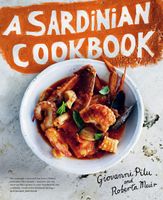Advertisement
Pasta and Rice
Pasta e Riso
By Giovanni Pilu and Roberta Muir
Published 2012

Sardinia grows a lot of durum wheat, which is perfect for making dried pasta, so it’s not surprising that pasta features strongly in the Sardinian diet. What may be surprising, though, is the wide variety of distinctive pasta shapes: the most popular is the shell-shaped malloreddus; then there are fat little ciciones, a type of gnocchi made with semolina flour; lombrichi, literally ‘little worms’; chewy, coin-shaped talluzzas; and maccarrones de busa, rolled along a knitting needle or steel rod. Fregola, toasted semolina pasta, is a legacy of the Arabic and North African influence on Sardinian food. In Sardinia, the name culurzones (also called gulurjones, culingiones or culurgiones, depending on the dialect) often refers to any filled pasta. Those made with the traditional filling of potato, cheese and mint, and distinctively shaped like an ear of wheat, are however unique to Sardinia. Rice dishes are also popular, as is couscous in some areas (mainly the south of the island, where the Arabic influence is strongest).

